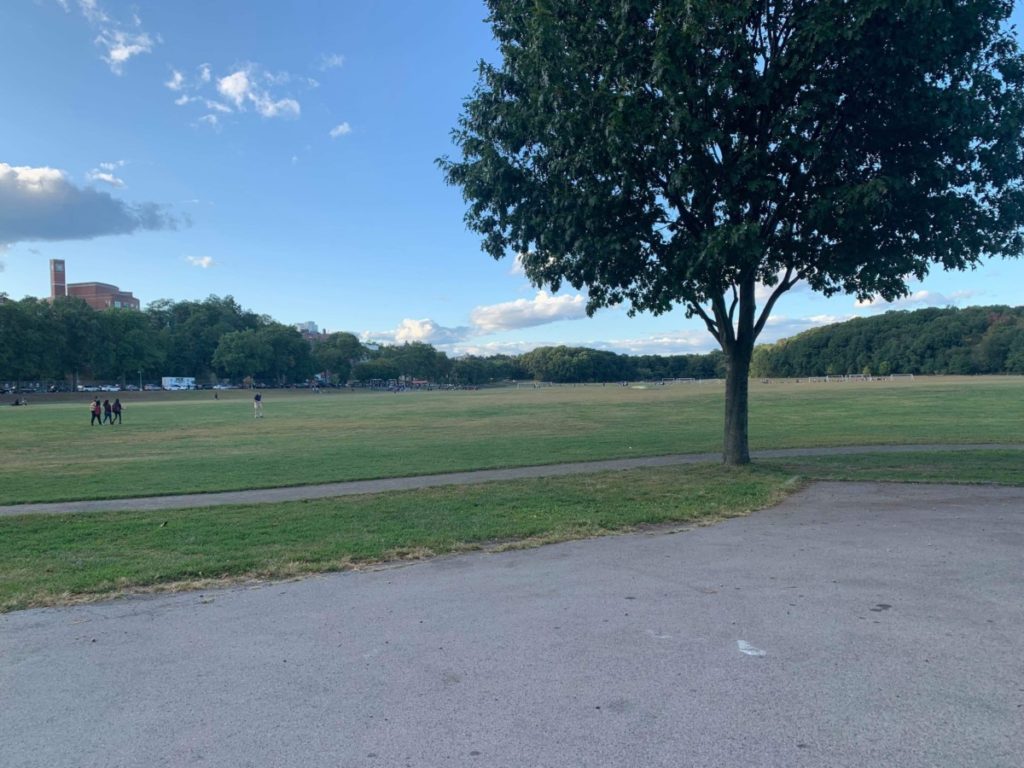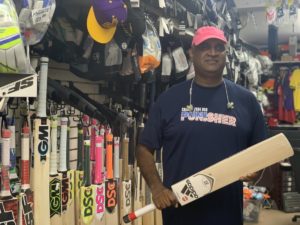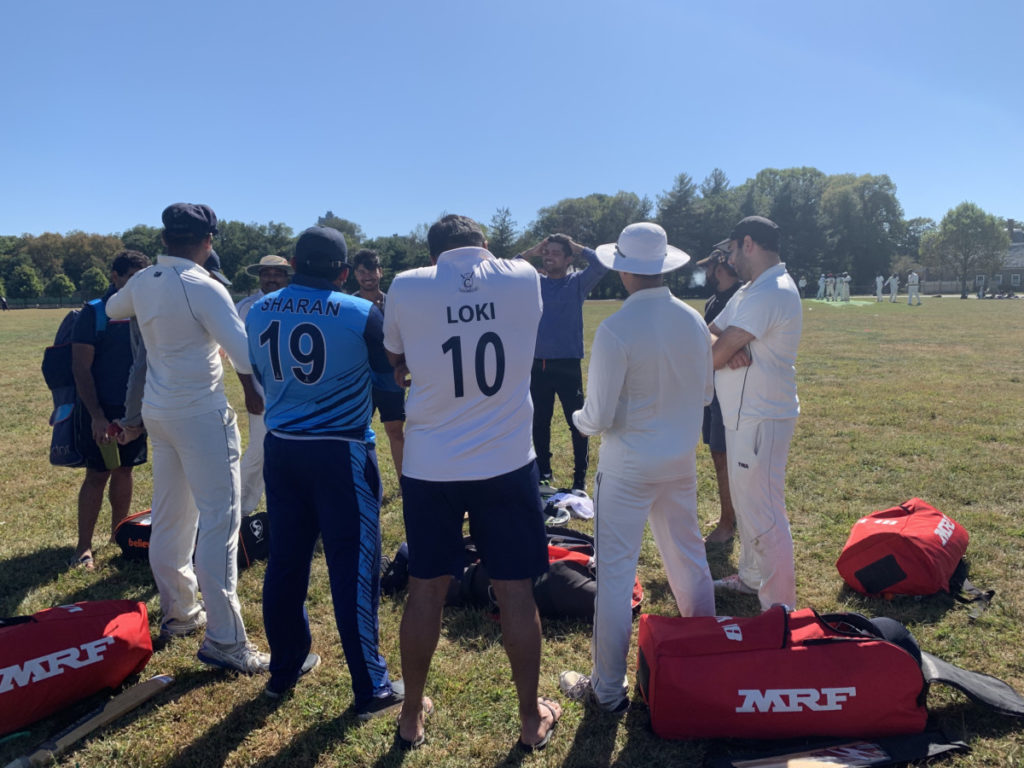
Dressed in classic cricket whites, the players waited for their batsman to play the match’s crucial moment in Van Cortlandt Park. The Columbia Cricket Club had only one more chance to beat the Long Island Kings, who had scored 114 runs. As the bowler pitched the ball, the players watched from their place on the cricket pitch. When the batsman struck the winning run, they erupted into cheers. Their teammates on the sidelines stormed the field. Columbia Cricket Club had chased 115 runs with three wickets to spare. The team was going to the league playoffs.

Every weekend, the Bronx’s Van Cortlandt Park becomes a hub for New York City cricket. On a Sunday morning in late September, the 1 train headed to the borough was packed with players lugging their bats and equipment. Family and friends set up beach chairs on the sidelines to watch games. Spectators kept score and retired players served as umpires. South Asian and Caribbean music played from portable speakers.
Queens, Brooklyn, and the Bronx are among the country’s cricket hotspots. In New York City alone, there are more than 200 teams.
Experts say the sport is one of the fastest-growing in the United States. The Bronx is home to immigrants from some of the world’s most cricket-devout countries, including a Bangladeshi population that has more than tripled since 1990.

“Cricket gives us identity. It’s like a culture to us. It’s like a religion. We can’t stop playing,” said Lokendra Chauhan, President of the Columbia Cricket Club.
Players from the Columbia Cricket Club, one of the largest clubs in New York City, are from India, Australia, Antigua, Pakistan, South Africa, England, New Zealand, Sri Lanka, and Bangladesh. It also has one of the few American-born players in the city, an Irish school teacher with no tradition of the sport.
For many immigrants, playing is a way to remain close to home and build community as they navigate life in the United States. “You have been living in one country, you leave everyone and everything behind for a better future,” said Chauhan, who is from India.
“Cricket brings us a family life.”
But the rapidly-growing, cricket-loving immigrant population has put increased pressure on the Bronx’s pitches, with demand for playing time exceeding available fields, according to borough cricket leadership.
The Bronx’s three home leagues—New York Cricket League, Commonwealth Cricket League, and the newer Royal Premier League—share the pitches at Van Cortlandt Park, Soundview Park, and Ferry Point Park.
“We need to play. We need space. There is a demand for space on the weekends,” said Milford Lewis, who was president of the New York Cricket League for 11 years until 2017.
A traditional cricket match lasts around five days, but the cab drivers, executives, waiters, doctors, lawyers, and janitors who play cricket in New York City can only play Saturdays and Sundays. In the Bronx, leagues usually play Twenty20, a shortened version of the sport played in three hours. But even the reduced game time hasn’t averted scheduling issues, since the Bronx has lost seven official pitches in the last six years.
*************

In 2013, the Department of Parks and Recreation injected $15 million to redesign the Parade Ground, a 66-acre swath of land used for cricket, soccer, baseball, football, cross-country, and Gaelic football at Van Cortlandt Park. The space was closed for three years until the construction was finished.
Renovations were a significant improvement—the pitches were made regulation size and designated exclusively for the sport with no field overlapping with other sports—but two fields were lost. It left the Bronx with 18, still more than any other borough. Brooklyn and Queens trailed behind with 16 and 13 fields respectively.
But other sports have since cut into cricket real estate. Just last year, the Department of Parks and Recreation took away two more pitches at the Parade Grounds to create three small-sided soccer fields.
The Bronx now has nine fields in Van Cortlandt Park and two in Ferry Point Park, putting the official number of dedicated pitches at 11. There is also a cricket pitch at Soundview Park and a softball field that doubles as a cricket pitch, but NYC Parks doesn’t list the spaces for play on its website as of September 2019, although players said they are still using them.
“Our pitches were designated solely for cricket. Now we have to share it with soccer, share it with frisbee, share it with athletics,” said Lewis, who is from Guyana. “If we can at least get one or two other pitches put out for us at any other ground in the Bronx, we will be thrilled. Cricket wants to get bigger, so we need bigger spaces.”
*************

Ravi Etwaroo, a Guyanese immigrant, has been running Cricket Zone USA, the Bronx’s only cricket store, since 2003. His clientele, which he estimates to be around 3,000 players from across the city, keeps him in the loop. Many of his customers complain about the need for more fields. Some say they have to commute to other boroughs to play. “Some have even stopped playing because it’s too inconvenient to play when you have to spend a whole day commuting and you have a family waiting at home,” Etwaroo said.
Leagues, in particular, are affected by the lack of space, since they are in charge of scheduling matches amongst their club members. They must apply to NYC Parks for a permit to play at public facilities.
In 2017, twenty-two permits were approved, none were denied, and fourteen were withdrawn. In 2019, twenty-seven were approved, 4 were denied, and four were withdrawn. These statistics don’t include the Soundview pitch.
“NYC Parks works hard to accommodate space and scheduling needs for all of our permit applicants,” said Anessa Hodgon, a press officer for the Department of Parks and Recreation. “Denied applications typically stem from lack of availability.”
But permit statistics don’t account for individuals, non-affiliated teams, and smaller leagues who might also want space to play but don’t apply because established teams are often grandfathered into the same time slots year after year. People without permits will often just hop into a field that isn’t in use.
They also don’t reflect league sizes. Commonwealth Cricket League has around 2,000 players and 162 teams across the city. “It’s the biggest cricket league in North America,” said President Lesley Lowe, who founded the league in 1980 with his father and brothers.
Lowe, the most senior cricket administrator in the country, agreed that there is a need for more fields, but doesn’t where they would go. “I’ve grown up here and played at Van Cortlandt since I was fourteen. I’ve scoped out the Bronx for pitches, inch by inch. A cricket field is twice the size of a baseball diamond. Where can we put that?”
*************
The lack of fields doesn’t only affect adult male teams, who dominate New York City’s cricket scene. It’s especially difficult for women to form teams and carry out regular practice meets since men’s teams have established tenure over many of the grounds.

Samantha Ramautar, a member of the women’s USA national cricket team, said that the lack of field availability impacts New York’s female cricket players, who only get together once or twice to play during the summer. She trains in a New Jersey facility that is one and a half hours away.
“We don’t get as many opportunities as the guys do,” she said, “If there were more facilities, you’d find more women that wouldn’t feel intimidated playing with the guys, and we would have more leagues.”
New York City is also the only city in the United States with cricket teams at public high schools. Three of the 34 participating schools are in the Bronx.“The public school cricket athletic league is the brainchild of the development of cricket in New York City,” said Milford Lewis, who has been an umpire since 1996 and often runs youth games.
Lewis says that the youth teams serve as feeders for the cricket scene, but that can be difficult to sustain when they don’t have regular, dedicated space to play. “They have to start playing in April to make sure everyone has time to use the pitches. I’ve done games where the temperature was in the 50s. Their hands are cold, their feet are cold, their faces are cold.”
*********
Bronx Community Board 9 Chairman William Rivera is working with NYC Parks to create the first cricket-dedicated pitch in his district at Pugsley and Randall Avenues. Rivera was inspired to pursue this initiative when he attended a cricket award ceremony at Parkchester’s Starling Avenue, which is a predominantly Bangladeshi area.“Children in my district grew up watching this sport in their birth countries, grew up watching their parents, and moved here later learning that this sport they love doesn’t have a real outlet for them to play,” he said.
USA Cricket, which was re-organized by the International Cricket Council last year, is hoping to rehabilitate New York’s cricket infrastructure as it invests $1 billion in the sport across the country over the next ten years. Its ambitious plans include a cricket stadium for international play in New York City. The Bronx is on the list of potential locations because of its large green spaces and vibrant cricket scene.
“If Bronx comes and says, we are ready to partner with you and we’ll give you a ten-acre park, we will help. Even if we forget about the stadium, even if they are looking to put a turf pitch, we are ready for that too,” said USA Cricket Club Director Ajith Baskar.

“That would be heaven,” said Columbia Cricket Club President Lokendra Chauhan. © Syra Ortiz-Blanes
Rather than creating more playing spaces, some cricket players believe that enhancing the current pitches could make the usage of space more efficient. Implementing floodlights, for example, could double playtime by making nighttime cricket possible. Better upkeep of the facilities, such as keeping grass short and installing natural turf pitches, would help New York teams train to compete at an international level. In turn, raising the sport’s visibility could give clubs and leagues leverage as they advocate for more space.
“If we have ambitions in New York to be delivering players that can step up at a high club and international level, the facilities here are inadequate at the moment to provide for that,” said Sumantro Das, a Columbia Cricket Club player from New Delhi.
*********
After winning its match against the Long Island Kings, the Columbia Cricket Club huddled together in a circle to debrief. Team officers gave a rousing speech to their players. They were proud of the work their team had done to secure the win. After the game, the players went for drinks to celebrate their victory.
This is what keeps bringing Das, who has been playing with his club for the last ten years, to the cricket pitches in the Bronx. He played professionally with the Birmingham League in England two summers ago and enjoys the competition and the thrill. But it’s the community aspect of it that he loves.
“This scene is vibrant. It’s exciting. The full breadth of diversity is incredible. It’s economic, it’s national, it’s community-wide, it’s international. It’s a beautiful picture.”







